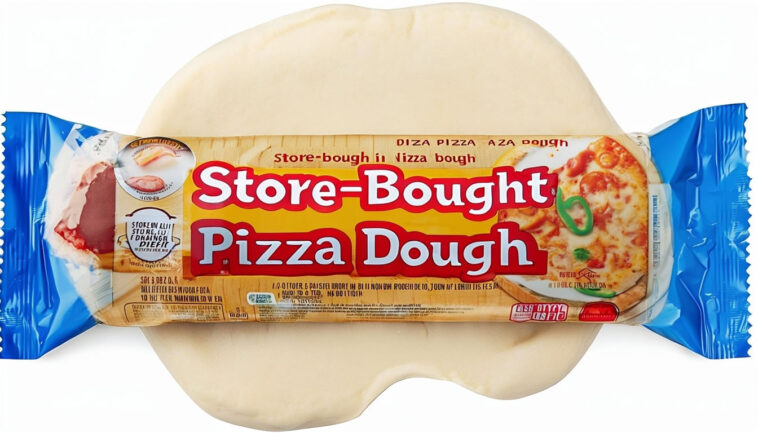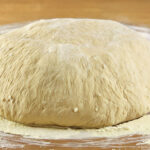If you’re a pizza lover but don’t have the time or energy to make pizza dough from scratch, store-bought pizza dough can be your best friend. It saves you time, effort, and allows you to enjoy the homemade pizza experience without the hassle of making the dough yourself. Whether you’re planning a quick weeknight dinner or a fun family pizza night, store-bought dough provides an easy and versatile option. In this article, we’ll cover everything you need to know How to Use Store-Bought Pizza Dough , including tips for getting the best results, creative ways to use it, and answers to common questions.
What Is Store-Bought Pizza Dough?
Store-bought pizza dough is pre-made dough that is available at most grocery stores in the refrigerated or frozen section. It typically contains basic pizza dough ingredients like flour, water, yeast, sugar, and salt. Some versions may include olive oil or other ingredients for flavor enhancement.
The dough comes in various forms: you might find it in a ball, ready to be rolled out, or pre-rolled and flat, which is even easier to use. All you need to do is shape it, add your favorite toppings, and bake it. This convenient option is great for people who want the homemade pizza experience without the lengthy dough-making process.
How to Use Store-Bought Pizza Dough Step-by-Step
Using store-bought pizza dough is simple, but there are some key steps to ensure you get the best results. Let’s walk through the process.
1. Bring the Dough to Room Temperature
Store-bought pizza dough is typically refrigerated or frozen, so it’s essential to bring it to room temperature before you start working with it. Cold dough can be stiff and hard to shape. Take the dough out of the fridge and let it sit at room temperature for about 30 minutes to an hour. If it’s frozen, you may need to let it thaw in the refrigerator for several hours or overnight before letting it reach room temperature.
2. Prepare Your Work Surface
Prevent dough from sticking: lightly flour your work surface and rolling pin before rolling out the pizza dough. You can also use parchment paper or a silicone baking mat if you want an easy transfer to the baking sheet or pizza stone later on.
3. Roll Out the Dough
Once the dough has reached room temperature, it’s ready to be rolled out to your desired thickness and shaped for toppings. Use a rolling pin to shape the dough into your desired size and thickness. For a thicker, chewier crust, roll it out less. For a thin and crispy crust, roll it out to about ¼ inch thick. If you don’t have a rolling pin, you can gently stretch the dough with your hands, working from the center outwards.
4. Pre-Bake the Dough (Optional)
If you want to ensure a crispy crust, consider pre-baking the pizza dough before adding toppings. This step is optional but highly recommended, especially for thick-crust pizzas or pizzas with a lot of toppings. Pre-bake the dough in a preheated oven at 450°F (232°C) for 5-7 minutes until it’s lightly browned but not fully cooked.
5. Add Your Toppings
Now comes the fun part—adding your favorite toppings! Start with a base layer of sauce, whether it’s tomato sauce, pesto, or white sauce. Then, layer on your choice of cheese, vegetables, meats, and other toppings. Be careful not to overload the pizza with too many toppings, as this can make the crust soggy.
6. Bake the Pizza
After you’ve added the toppings, bake the pizza in a preheated oven at 450°F (232°C) for 10-15 minutes or until the crust is golden brown and the cheese is bubbly. If you pre-baked the crust, you may need to reduce the cooking time slightly. If you’re using a pizza stone, preheat the stone in the oven for 30 minutes before placing the pizza on it to ensure an even, crispy crust.
7. Let It Rest and Serve
Once the pizza is done baking, remove it from the oven and let it rest for a few minutes before slicing. Letting the pizza rest for a few minutes after baking allows the cheese to set, making it easier to slice and serve.

Creative Ways to Use Store-Bought Pizza Dough
Store-bought pizza dough isn’t just for pizza—it’s a versatile ingredient that can be used for various other delicious recipes. Explore New Possibilities:
1. Calzones
A calzone is like a pizza pocket. Roll out the dough, add your fillings (cheese, meats, vegetables), fold it over, and seal the edges. Bake until golden for a handheld, portable pizza experience.
2. Breadsticks
To make homemade breadsticks, roll out the dough, cut it into strips, and twist them. Brush with melted butter or olive oil, sprinkle with garlic powder and parmesan, and bake until golden.
3. Garlic Knots
Roll the dough into small balls, then tie each ball into a knot. Bake until golden and brush with garlic butter for delicious homemade garlic knots.
4. Pizza Rolls
Similar to cinnamon rolls but savory, pizza rolls are made by spreading sauce, cheese, and toppings on rolled-out dough, then rolling it up and slicing into rounds. Bake till golden, then indulge: Serve with a side of marinara sauce for delicious dipping.
5. Flatbreads
If you prefer something lighter than traditional pizza, use the dough to make flatbreads. Simply roll it out thin, brush with olive oil, and top with light ingredients like arugula, prosciutto, or goat cheese. Bake until crispy.
Tips for Using Store-Bought Pizza Dough
Using store-bought pizza dough is straightforward, but these tips will help you get the best results:
1. Don’t Overwork the Dough
Overworking pizza dough can make it tough and chewy. Roll and stretch with gentle touch If the dough keeps shrinking back as you try to shape it, let it rest for a few more minutes to relax the gluten.
2. Preheat Your Oven
Make sure your oven is fully preheated before putting the pizza in. Baking pizza at a high temperature ensures a crispy crust and well-cooked toppings.
3. Baking Essentials: Stone or Steel
Use a pizza stone or baking steel for a crisper crust, golden brown base, and authentic flavor. These tools help distribute heat evenly and absorb moisture, which results in a perfectly crisp crust.
4. Dust with Cornmeal
Before baking, dust your baking sheet or pizza stone with cornmeal. This prevents the dough from sticking and gives the crust a slightly crunchy texture.
5. Avoid Overloading the Pizza
While it’s tempting to pile on lots of toppings, be careful not to overload your pizza. Don’t overdo it! Too many toppings can make the crust soggy and weigh down the dough.
6. Use Parchment Paper for Easy Transfer
If you’re worried about transferring your pizza to a hot stone or baking sheet, build the pizza on parchment paper. Parchment or floured peel for easy transfer.
FAQ
Q1. Can You Freeze Store-Bought Pizza Dough?
A. Yes, most store-bought pizza dough can be frozen for future use. If it’s not already frozen when you purchase it, you can divide it into portions and freeze it in airtight containers or freezer bags. To thaw, place the dough in the refrigerator overnight, then bring it to room temperature before using.
Q2. How Long Does Store-Bought Pizza Dough Last in the Fridge?
A. Store-bought pizza dough typically lasts for 3-5 days in the refrigerator, depending on the brand. Always check the expiration date on the packaging, and store the dough in an airtight container to prevent it from drying out.
Q3. Can You Make Gluten-Free Pizza with Store-Bought Dough?
A. Yes, many stores offer gluten-free pizza dough options. Look for gluten-free dough in the refrigerated or frozen section of your local grocery store. Follow the same steps as with regular dough, keeping in mind that gluten-free dough may be more delicate and require a gentler touch when rolling and shaping.
Q4. Can I Use Store-Bought Pizza Dough for Grilling?
A. Absolutely! Store-bought pizza dough is great for grilling. Roll out the dough, brush one side with olive oil, and place it directly on the grill. Grill pizza 2-3 minutes per side, adding toppings after flipping, until cheese melts and crust is cooked through.
Q5. How Do I Keep My Store-Bought Pizza Dough from Getting Soggy?
- To prevent a soggy crust, consider pre-baking the dough before adding toppings. Also, avoid using too much sauce or watery toppings like fresh tomatoes, which can release moisture during baking. If using vegetables, consider sautéing or roasting them beforehand to remove excess water.
Q6. How do I know when the pizza is done baking?
- Cooked to perfection: golden crust, melted, bubbly cheese. You can also use a thermometer; the internal temperature should reach about 200°F (93°C).
Q7. Can I use gluten-free pizza dough?
- Absolutely! Many brands offer gluten-free pizza dough options. Follow the same preparation steps, but be aware that gluten-free dough may require different baking times
.
Q8. What toppings work best with store-bought dough?
- The possibilities are endless! Common toppings include pepperoni, mushrooms, bell peppers, onions, olives, and fresh basil. Experiment with your favorites!
Q9. Can I make dessert pizza with store-bought dough?
- Yes! Use the dough to create dessert pizzas by topping it with ingredients like Nutella, fruits, and a sprinkle of powdered sugar after baking.
Q10. Is it safe to leave pizza dough out at room temperature?
- Store-bought pizza dough should not be left out for more than two hours due to food safety concerns. Always refrigerate or freeze any unused dough.
Q11. Can I use store-bought dough for calzones or stuffed pizzas?
- Yes! Store-bought dough is versatile and can be used to make calzones, stuffed pizzas, or even breadsticks. Just adjust the filling and cooking time as needed.
Using store-bought pizza dough is a fantastic way to enjoy homemade pizza without the time-consuming process of making dough from scratch. With the right techniques, tips, and toppings, you can create delicious, customized pizzas that cater to your taste preferences. Whether you’re hosting a pizza night with friends or enjoying a cozy meal with family, store-bought dough offers convenience and versatility. So grab your favorite ingredients, unleash your creativity, and get ready to enjoy a slice of deliciousness!
This article provided detailed instructions on using store-bought pizza dough, creative ways to incorporate it into various dishes, helpful tips for getting the best results, and answers to common questions.




